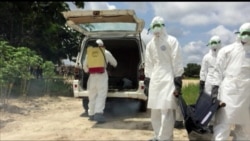The Ebola epidemic that swept through Liberia, Guinea and Sierra Leone during 2014 and the first half of 2015 was by far the worst outbreak of the disease ever, killing thousands of people. Countries with already poor health care systems struggled to contain the early stages of the outbreak, and one of the worst problems they faced was the lack of any quick, reliable way to identify patients infected with the virus.
“Tests would take two or three, sometimes four days to get results back" to hospitals, recalls Matt Scullion of BioFire Defense, a biotechnology firm in Utah. "In the meantime you had malaria patients in with Ebola patients, and if you didn't have Ebola before, you'd be likely to have Ebola after.”
Images that linger after the outbreak ended are stark reminders of the suffering in West Africa: deserted villages, a little girl found alone in a house with her sister dying of Ebola, a husband watching his dead wife being carried away by undertakers, a gravedigger wearing worn-out personal protective equipment, and thus likely to become a patient soon himself.
But as Ebola was multiplying unchecked across large areas of West Africa, a rapid-testing kit that had been in the works for years was ready to go at BioFire Defense, more than 10,000 kilometers away in the western United States.
The U.S. firm, a subsidiary of a large French biomedical corporation, focuses on innovative technologies to help workers in the life sciences identify pathogens quickly and easily. Cynthia Phillips worked on BioFire Defense's Ebola testing kit, known as FilmArray.
Test results in an hour
“The FilmArray kit is both an instrument that is a diagnostic, and a little pouch that’s room-temperature stable that you put a human sample in and some water," Phillips said.
"You put [the sample] into the instrument and it gives you back results on a whole series of tests for pathogens - about 30, usually," she told VOA, adding that the U.S. Defense Department had previously asked the firm to include Ebola among the pathogens its kits can identify.
"We had, I think, three [working] tests before the Ebola outbreak, on two different platforms," Phillips said.
By the time it was ready to distribute its FilmArray kits, BioFire Defense's Scullion said, "The device gave us the ability to test patients in one hour."
WHO-approved diagnostic tools
FilmArray is now one of seven diagnostic tools the World Health Organization has approved for emergency use.
“Before we had to transport samples to Dakar, Senegal, or Lyon, France. But today, thanks to our partners in France, the CDC in the U.S., and many others, we are able to make rapid diagnoses for Ebola,” the inspector general of Guinea's Health Ministry, Aboubakar Sidiki Diakite, told VOA.
"Ebola is a frightening disease, very infectious, and the mortality rate is quite high, and that shouldn’t be taken lightly," said Scullion, who is BioFire Defense's business development director.
During the height of the Ebola crisis, when the first patient evacuated to the U.S. for treatment, he recalled that hospital personnel "had problems just getting couriers to deliver samples to the Centers for Disease Control. That's how big of a fear there was around the handling of a package that had suspected Ebola samples in it."
The first Ebola patient to arrive on U.S. soil was an American physician who had been working in Liberia, Kent Brantly.
Test kit allayed lab workers' fears
Eileen Burd, a professor of pathology and the clinical microbiology director at Emory University Hospital in Atlanta, recalls those first days.
“In the laboratory, we felt comfortable with the level of protective equipment, we felt comfortable with our abilities to do the test," Burd told VOA. "But I’ll admit, the first time I opened that first tube of blood, knowing what was in there and what it was doing to the patient down the hall was daunting. So it gave me pause, but then you take a deep breath and ... do the work you need to do.”
“Shortly after our first patient arrived we started using the BioFire FilmArray Ebola Kit," Burd said. "We were lucky that our patients came in [with confirmed Ebola infections], so we didn’t have to use [the kit] to make the diagnosis. But we did use it to follow patients, to test different specimen types … and for patients under investigation, worried travelers.
"We always backed it up with a test at the CDC (which also is in Atlanta) but it was wonderful in this epidemic that the test was available."
Like Professor Burd, Dr. Colleen Kraft is an infectious-diseases specialist and medical microbiologist at Emory. She also was one of the physicians who treated the hospital's Ebola patients, and she agreed that easy and quick testing is critical to enable the rapid detection and management of Ebola virus infections.
"The crucial part of testing is really moving the patient to the right next place, so is the right next place to be admitted to the Ebola treatment unit or is the right next place to be able to go home and not be in a place where they could contract it from another patient?" Dr. Kraft noted.
The World Health Organization declared in May 2015 that the Ebola outbreak of 2014 in West Africa was over, and has since declared that Ebola no longer is "a public health emergency of international concern." However, scattered clusters of cases have been reported every few months, and medical experts caution that no one should conclude that the deadly virus is no longer a risk. They hope that better preparation for future outbreaks and rapid testing tools can drastically lower future death tolls.
SALT LAKE CITY —






